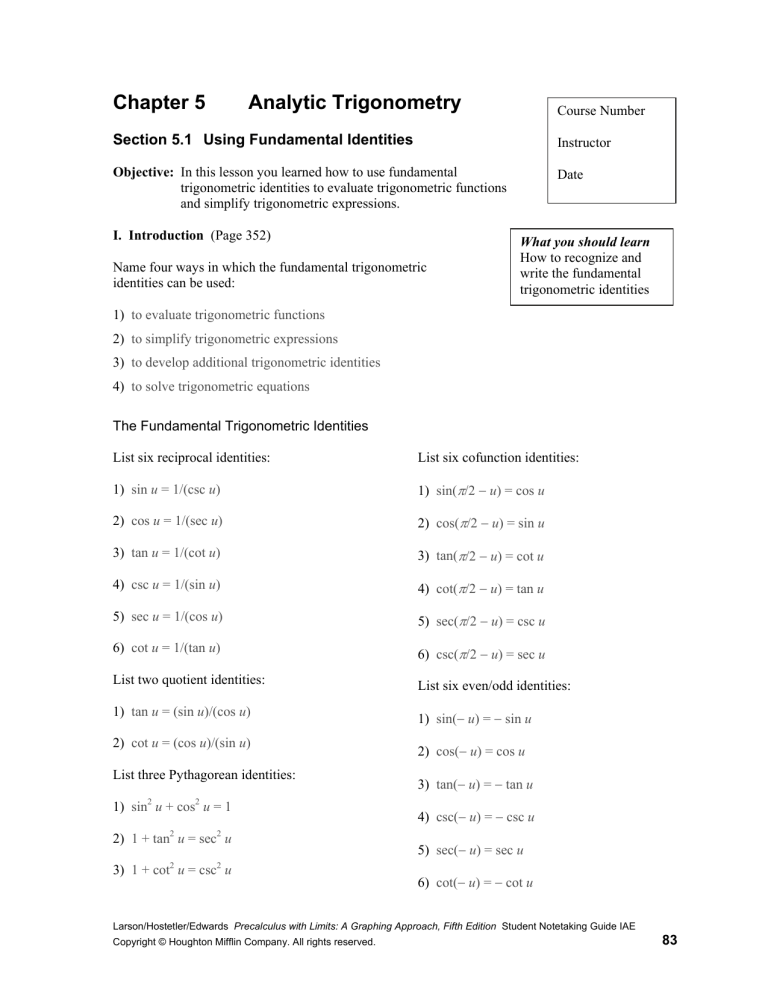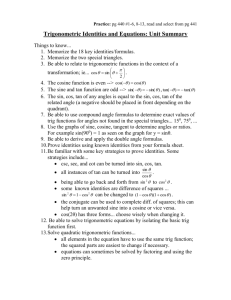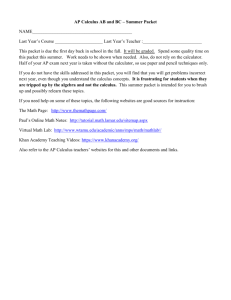chapter 5 student notes

Chapter 5 Analytic Trigonometry
Section 5.1 Using Fundamental Identities
Objective: In this lesson you learned how to use fundamental trigonometric identities to evaluate trigonometric functions and simplify trigonometric expressions.
I. Introduction (Page 352)
Name four ways in which the fundamental trigonometric identities can be used:
1) to evaluate trigonometric functions
2) to simplify trigonometric expressions
3) to develop additional trigonometric identities
4) to solve trigonometric equations
The Fundamental Trigonometric Identities
List six reciprocal identities:
1) sin u = 1/(csc u )
2) cos u = 1/(sec u )
3) tan u = 1/(cot u )
4) csc u = 1/(sin u )
5) sec u = 1/(cos u )
6) cot u = 1/(tan u )
List two quotient identities:
1) tan u = (sin u )/(cos u )
2) cot u = (cos u )/(sin u )
List three Pythagorean identities:
1) sin 2 u + cos 2 u = 1
2) 1 + tan 2 u = sec 2 u
3) 1 + cot 2 u = csc 2 u
Course Number
Instructor
Date
What you should learn
How to recognize and write the fundamental trigonometric identities
List six cofunction identities:
1) sin( π /2 − u ) = cos u
2) cos( π /2 − u ) = sin u
3) tan( π /2 − u ) = cot u
4) cot( π /2 − u ) = tan u
5) sec( π /2 − u ) = csc u
6) csc( π /2 − u ) = sec u
List six even/odd identities:
1) sin( − u ) = − sin u
2) cos( − u ) = cos u
3) tan( − u ) = − tan u
4) csc( − u ) = − csc u
5) sec( − u ) = sec u
6) cot( − u ) = − cot u
Larson/Hostetler/Edwards Precalculus with Limits: A Graphing Approach, Fifth Edition Student Notetaking Guide IAE
Copyright © Houghton Mifflin Company. All rights reserved.
83
84 Chapter 5 Analytic Trigonometry
II. Using the Fundamental Identities (Pages 352 − 356)
Example 1: Explain how to use the fundamental trigonometric identities to find the value of tan u given that sec u = 2 .
Use the Pythagorean identity 1 + tan 2 u = sec 2 u .
Substitute 2 for the value of sec u and solve for tan u .
Example 2: Explain how to use the fundamental trigonometric identities to simplify sec x − tan x sin x .
Rewrite the expression in terms of sines and cosines. Combine the resulting fractions to obtain
(1 − sin 2 x )/(cos x ). Using the Pythagorean identity sin 2 u + cos 2 u = 1, replace the numerator with cos 2 x . Simplify the result to obtain cos x .
Example 3: Explain how to use a graphing utility to verify whether identity. sec x sin
3 x + sin x cos x = tan x is an
Graph y
1
= sec x sin 3 x + sin x cos x and y
2
= tan x in the same viewing window. If the two graphs appear to coincide, the expressions appear to be equivalent and the equation is an identity. If the two graphs do not coincide, then the equation is not an identity.
What you should learn
How to use the fundamental trigonometric identities to evaluate trigonometric functions, simplify trigonometric expressions, and rewrite trigonometric expressions
Homework Assignment
Page(s)
Exercises
Larson/Hostetler/Edwards Student Notetaking Guide IAE
Copyright © Houghton Mifflin Company. All rights reserved.
Section 5.2 Verifying Trigonometric Identities 85
Section 5.2 Verifying Trigonometric Identities
Objective: In this lesson you learned how to verify trigonometric identities.
I. Introduction (Page 360)
The key to both verifying identities and solving equations is . . . the ability to use the fundamental identities and the rules of algebra to rewrite trigonometric expressions.
An identity is . . . an equation that is true for all real values in the domain of the variable.
II. Verifying Trigonometric Identities (Pages 360 − 364)
Complete the following list of guidelines for verifying trigonometric identities:
1) Work with one side of the equation at a time. It is often better to work with the more complicated side first.
2) Look for opportunities to factor an expression, add fractions, square a binomial, or create a monomial denominator.
3) Look for opportunities to use the fundamental identities. Note which functions are in the final expression you want. Sines and cosines pair up well, as do secants and tangents, and cosecants and cotangents.
4) If the preceding guidelines do not help, try converting all terms to sines and cosines.
5) Always try something! Even making an attempt that leads to a dead end provides insight.
Example 1: Describe a strategy for verifying the identity sin θ tan θ + cos θ = sec θ . Then verify the identity.
Begin by converting all terms to sines and cosines.
Course Number
Instructor
Date
What you should learn
How to understand the difference between conditional equations and identities
What you should learn
How to verify trigonometric identities
Larson/Hostetler/Edwards Precalculus with Limits: A Graphing Approach, Fifth Edition Student Notetaking Guide IAE
Copyright © Houghton Mifflin Company. All rights reserved.
86 Chapter 5 Analytic Trigonometry
Example 2: Describe a strategy for verifying the identity sin 2 x (csc x − 1 )(csc x + 1 ) = 1 − sin 2 x . Then verify the identity.
Because the left side is more complicated, start with it. Begin by multiplying (csc x − 1) by
(csc x + 1), and then search for a fundamental identity that can be used to replace the result.
Example 3: Verify the identity cot
Additional notes
5 α = cot
3 α csc
2 α − cot
3 α .
Homework Assignment
Page(s)
Exercises
Larson/Hostetler/Edwards Student Notetaking Guide IAE
Copyright © Houghton Mifflin Company. All rights reserved.
Section 5.3 Solving Trigonometric Equations
Section 5.3 Solving Trigonometric Equations
Objective: In this lesson you learned how to use standard algebraic techniques and inverse trigonometric functions to solve trigonometric equations.
I. Introduction (Pages 368 − 370)
To solve a trigonometric equation, . . . use standard algebraic techniques such as collecting like terms and factoring.
The preliminary goal in solving trigonometric equations is . . . to isolate the trigonometric function involved in the equation.
How many solutions does the equation sec x = 2 have? Explain.
The equation has an infinite number of solutions because the secant function has a period of 2 π . Any angles coterminal with the equation’s solutions on [0, 2 π ) will also be solutions of the equation.
Example 1: Solve cos 2 x − 1 = 0 . x = π /4 + n π , x = 3 π /4 + n π
To solve an equation in which two or more trigonometric functions occur, . . . collect all terms on one side and try to separate the functions by factoring or by using appropriate identities.
II. Equations of Quadratic Type (Pages 370 − 372)
Give an example of a trigonometric equation of quadratic type.
Answers will vary. For example, cos 2 x + 4 cos x + 4 = 0.
To solve a trigonometric equation of quadratic type, . . . factor the quadratic, or if factoring is not possible, use the
Quadratic Formula.
Course Number
Instructor
Date
What you should learn
How to use standard algebraic techniques to solve trigonometric equations
What you should learn
How to solve trigonometric equations of quadratic type
87
Larson/Hostetler/Edwards Precalculus with Limits: A Graphing Approach, Fifth Edition Student Notetaking Guide IAE
Copyright © Houghton Mifflin Company. All rights reserved.
88
Example 2: Solve 2 x + 2 tan x = − 1 . x = 3 π /4 + n π
Care must be taken when squaring each side of a trigonometric equation to obtain a quadratic because . . . this procedure can introduce extraneous solutions, so any solutions must be checked in the original equation to see whether they are valid or extraneous.
III. Functions Involving Multiple Angles (Page 373)
Give an example of a trigonometric function of multiple angles.
Answers will vary. For example, tan 4 x .
Example 3: Solve 4 x =
2
.
2 x = π /16 + n π /2 and x = 3 π /16 + n π /2
IV. Using Inverse Functions (Page 374 − 375)
Example 4: Use inverse functions to solve the equation tan 2 x + 4 tan x + 4 = 0. x = arctan ( − 2) + n π
Chapter 5 Analytic Trigonometry
What you should learn
How to solve trigonometric equations involving multiple angles
What you should learn
How to use inverse trigonometric functions to solve trigonometric equations
Homework Assignment
Page(s)
Exercises
Larson/Hostetler/Edwards Student Notetaking Guide IAE
Copyright © Houghton Mifflin Company. All rights reserved.
Section 5.4 Sum and Difference Formulas
Section 5.4 Sum and Difference Formulas
Objective: In this lesson you learned how to use sum and difference formulas to rewrite and evaluate trigonometric functions.
I. Using Sum and Difference Formulas (Pages 380 − 383)
List the sum and difference formulas for sine, cosine, and tangent. sin( u + v ) = sin u cos v + cos u sin v sin( u − v ) = sin u cos v − cos u sin v cos( u + v ) = cos u cos v − sin u sin v cos( u − v ) = cos u cos v + sin u sin v tan( u + v ) = (tan u + tan v )/(1 − tan u tan v ) tan( u − v ) = (tan u − tan v )/(1 + tan u tan v )
Example 1: Use a sum or difference formula to find the exact value of tan 255 ° .
(9 + 6 √ 3 + 3)/6
Example 2: Find the exact value of cos 95 ° cos 35 ° + sin 95 ° sin 35 ° .
1/2
A reduction formula is . . . a formula involving expressions such as sin( θ + n π /2) or cos( θ + n π /2), where n is an integer, that can be derived from sum and difference formulas.
π
2 ⎠
⎟
⎞
. Example 3: Derive a reduction formula for sin
⎝
⎜ sin( t + π /2) = cos t
Course Number
Instructor
Date
What you should learn
How to use sum and difference formulas to evaluate trigonometric functions, to verify identities, and to solve trigonometric equations
89
Larson/Hostetler/Edwards Precalculus with Limits: A Graphing Approach, Fifth Edition Student Notetaking Guide IAE
Copyright © Houghton Mifflin Company. All rights reserved.
90
Example 4: Find all solutions of cos( x −
π
3
) in the interval [0, 2 x = 0
Additional notes
π ).
+ cos( x +
π
3
) = 1
Chapter 5 Analytic Trigonometry
Homework Assignment
Page(s)
Exercises
Larson/Hostetler/Edwards Student Notetaking Guide IAE
Copyright © Houghton Mifflin Company. All rights reserved.
Section 5.5 Multiple-Angle and Product-to-Sum Formulas
Section 5.5 Multiple-Angle and Product-to-Sum Formulas
Objective: In this lesson you learned how to use multiple-angle formulas, power-reducing formulas, half-angle formulas, and product-to-sum formulas to rewrite and evaluate trigonometric functions.
I. Multiple-Angle Formulas (Pages 387 − 389)
The most commonly used multiple-angle formulas are the
double-angle formulas , which are listed below: sin 2 u = 2 sin u cos u cos 2 u = cos 2 u − sin 2 u
Course Number
Instructor
Date
What you should learn
How to use multipleangle formulas to rewrite and evaluate trigonometric functions
2 cos 2 u − 1
= − 2 sin 2 u tan 2 u = (2 tan u )/(1 − tan 2 u )
To obtain other multiple-angle formulas, . . . use 4 θ and 2 θ or 6 θ and 3 θ in place of 2 θ and θ in the double-angle formulas or using the double-angle formulas together with the appropriate trigonometric sum formulas.
Example 1: Use multiple-angle formulas to express cos 3 x in terms of cos x .
4 cos 3 x − 3 cos x
II. Power-Reducing Formulas (Page 389)
The double-angle formulas can be used to obtain the
power-reducing formulas .
What you should learn
How to use powerreducing formulas to rewrite and evaluate trigonometric functions
91
Larson/Hostetler/Edwards Precalculus with Limits: A Graphing Approach, Fifth Edition Student Notetaking Guide IAE
Copyright © Houghton Mifflin Company. All rights reserved.
92
The power-reducing formulas are: sin 2 u = (1 − cos 2 u )/2 cos 2 u = (1 + cos 2 u )/2 tan 2 u = (1 − cos 2 u )/(1 + cos 2 u )
III. Half-Angle Formulas (Pages 390 − 391)
List the half-angle formulas: sin u
2
= ± √ (1 − cos u )/2 cos u
= ± √ (1 + cos u )/2
2 tan u
= (1 − cos u )/(sin u ) = (sin u )/(1 + cos u )
2
The signs of sin ( u /2) and cos ( u /2) depend on . . . the quadrant in which u /2 lies.
Example 2: Find the exact value of tan 15 ° .
2 − √ 3
IV. Product-to-Sum Formulas (Pages 391 − 393)
The product-to-sum formulas are used in calculus to . . . evaluate integrals involving the products of sines and cosines of two different angles.
The product-to-sum formulas are: sin u sin v = 1/2[cos( u − v ) − cos ( u + v )] cos u cos v = 1/2[cos( u − v ) + cos ( u + v )] sin u cos v = 1/2[sin( u + v ) + sin( u − v )] cos u sin v = 1/2[sin( u + v ) − sin( u − v )]
Chapter 5 Analytic Trigonometry
What you should learn
How to use half-angle formulas to rewrite and evaluate trigonometric functions
What you should learn
How to use product-tosum and sum-to-product formulas to rewrite and evaluate trigonometric functions
Larson/Hostetler/Edwards Student Notetaking Guide IAE
Copyright © Houghton Mifflin Company. All rights reserved.
Section 5.5 Multiple-Angle and Product-to-Sum Formulas
Example 3: Write cos 3 x cos 2 x as a sum or difference.
1/2 cos x + 1/2 cos 5 x
The sum-to-product formulas can be used to . . . rewrite a sum or difference of trigonometric functions as a product.
The sum-to-product formulas are: sin u + sin v = 2 sin(( u + v )/2) cos(( u − v )/2) sin u − sin v = 2 cos(( u + v )/2) sin(( u − v )/2) cos u + cos v = 2 cos(( u + v )/2) cos(( u − v )/2) cos u − cos v = − 2 sin(( u + v )/2) sin(( u − y )/2)
Example 4: Write cos 4 x + cos 2 x as a sum or difference.
2 cos 3 x cos x
Additional notes
Larson/Hostetler/Edwards Precalculus with Limits: A Graphing Approach, Fifth Edition Student Notetaking Guide IAE
Copyright © Houghton Mifflin Company. All rights reserved.
93
94
Additional notes
Homework Assignment
Page(s)
Exercises
Chapter 5 Analytic Trigonometry
Larson/Hostetler/Edwards Student Notetaking Guide IAE
Copyright © Houghton Mifflin Company. All rights reserved.






